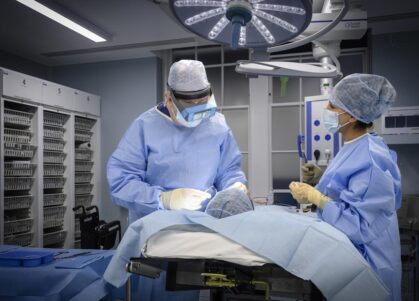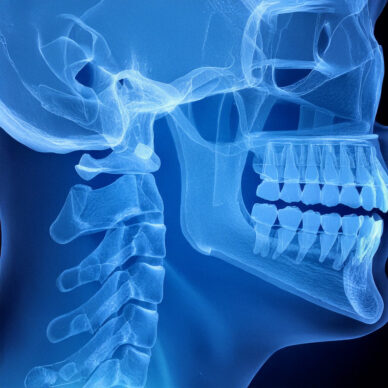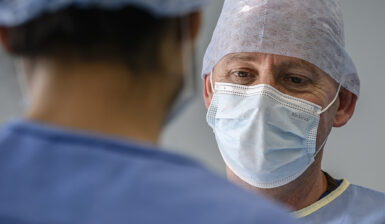Conditions Treated by Orthognathic Surgery
TMJ (temporomandibular joint) Disorders
TMJ (temporomandibular joint) disorders occur when the jaw joint is misaligned or under strain, leading to symptoms like jaw pain, clicking, locking, and difficulty opening or closing the mouth. Misaligned jaws can put extra stress on the TMJ, causing chronic discomfort and even headaches. Orthognathic surgery can help by repositioning the jaw to reduce strain on the joint, improving function and relieving pain when other treatments haven’t worked.
Facial Asymmetry
Uneven jaw growth can lead to facial asymmetry, affecting appearance and functionality. Surgery can correct issues like a lopsided chin, an unbalanced smile, or significant jaw misalignment, restoring symmetry for a more natural look.
Improved Bite & Breathing
Misaligned jaws can make chewing difficult, cause uneven tooth wear, and contribute to speech problems. Additionally, jaw misalignment can obstruct airways, leading to breathing issues like sleep apnea. Orthognathic surgery improves both bite efficiency and airway function, enhancing overall health.
Sleep Apnea
Sleep apnea is a condition where breathing repeatedly stops and starts during sleep due to a blocked or narrow airway, often caused by a small or recessed jaw. This can lead to loud snoring, daytime fatigue, and serious health risks like high blood pressure and heart problems. Orthognathic surgery repositions the jaws to open the airway, significantly improving airflow and reducing or even eliminating sleep apnea symptoms.
Diagnosis Of Jaw Alignment
Care at our London clinic is provided by a maxillofacial consultant who is highly experienced in orthognathic surgery. They will conduct a thorough physical examination, review any relevant medical conditions, and discuss your treatment options in detail.
As part of the planning process, we may use models, X-rays, or computer analysis to map out the procedure. Our lead orthodontist may also be involved, as orthodontic care often plays a key role at various stages of your treatment.
Orthognathic surgery is typically recommended when orthodontics alone cannot correct your bite. This is often due to significant asymmetry, such as a considerable size difference between the upper and lower jaw, which cannot be fixed by braces alone.
Braces may still be needed both before and after the surgery to ensure your teeth align correctly. Wearing them for a period before the procedure and for some time afterwards is usually part of the treatment plan.
Mandibular Osteotomy Procedure
The technique used for jaw repositioning is called mandibular osteotomy, which involves carefully cutting and moving the jaw to a new position. This surgery is performed at a reputable London hospital under general anaesthesia, with a hospital stay of one or two nights typically required.
In some cases, a small external incision near the jaw may be needed, but this would quickly heal and become nearly invisible, and it is quite rare. The surgery is generally carried out from inside the mouth, leaving no external scars.
Once the jaw is repositioned, tiny titanium plates and screws are used to secure it in place. While these plates and screws are usually left in place permanently, there may be situations where they are removed.
After the surgery, retainers may be used to guide your teeth into their new positions. While your teeth are not typically wired together, small elastic bands are likely to be used for a period of time to help maintain proper alignment.
Recovery & Post Surgery
Orthognathic surgery is a significant procedure that can cause bleeding and some short-term discomfort. You are more likely to experience numbness and swelling rather than significant pain.
Your mouth will open normally after the surgery, and eating and drinking are encouraged from an early stage. However, due to initial swelling and the use of elastic bands, a soft diet may be required for a few weeks.
By this time, any pain should have subsided, though some form of ongoing treatment may still be necessary. Braces may remain in place for several months or may be replaced with a removable retainer.
In rare cases, a second operation may be needed to fine-tune the bite. As with any complex surgery, there is a potential for nerve damage or other issues, but your consultant will discuss these risks in detail with you before the procedure.
Specialised Care
Whatever your personal reasons for seeking treatment, whether it’s time spent in braces before or after surgery, orthognathic treatment can take up to two years.
This is a commitment from both our patients and the consultant, supported by the dedicated staff at our London clinic. We share your goals, and with our expertise, we are confident we can help you achieve the results you desire.
Your bite will be improved, offering practical, social, and even medical benefits. You will notice a difference in your appearance, and while the extent of change depends on the original issue, your features should become more balanced and natural.
Achieving the final result may take some time following surgery. We will schedule follow-up appointments, and any advice or support you need will always be available.
The vast majority of our patients are extremely pleased with the outcomes of their orthognathic surgery. If we can assist you in any way, please don’t hesitate to get in touch.








